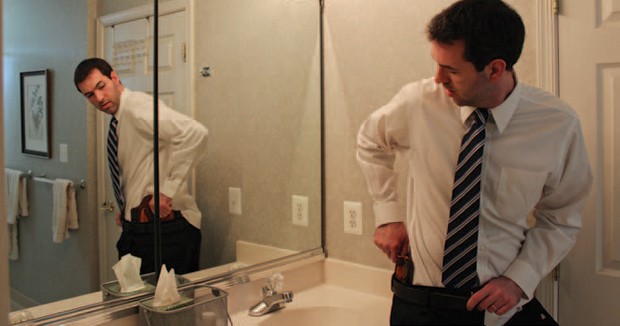Whether you wear a three-piece suit every day or only dress up for special events, it’s worth knowing how to conceal carry in dress clothes just in case you ever need to do it. The basic principles of concealing a weapon are the same no matter your attire, but with our tips, you’ll be able to avoid common concealment failures specific to dress clothes.

DRESS CLOTHES CONCEALING BASICS
When concealing a firearm in dress clothes, or any attire really, there are three important decisions to make:
- What weapon will you carry?
- Where will you carry your weapon?
- What clothing will you wear?
Concealed carrying boils down to selecting a firearm you’re comfortable handling, purchasing a holster suitable for your firearm and your carrying location, and covering it with your clothing.
FABRIC TIPS
When concealing a weapon in dress clothes, it’s important to consider the fabrics you’ll be wearing. Rather than a stiff pair of jeans, you’ll be wearing loose slacks or a dress. When possible, choose a smooth gun over one with excessive texture. Guns with large barrel sights, raised lettering, and large safety latches are more likely to show through your clothes.
Some people find greater success concealing under patterned clothes rather than solids. Also, consider the weight of your fabrics. Light, clingy fabrics are more likely to show the outline of your weapon. An Oxford shirt has a thicker weave than a poplin and will drape more loosely. Thicker weaves are also more opaque and less likely to show the dark metal of your gun through your shirt.
For ladies, wearing a camisole under your top can greatly reduce printing through any light, flowy top you may wear. Also, it prevents loose tops from shifting and getting wedged between your skin and your holster.
LAYERING CONSIDERATIONS
Dressing up often involves wearing multiple layers of clothes. When deciding where you’re going to carry your weapon, you should give considerable thought to whether you’ll be removing layers at any point.
If you intend to carry your weapon in the pocket of your suit jacket, your ability to remove the jacket is greatly reduced. Not only does it become a safety issue to leave your gun laying around with your jacket, but it also strips you of your valuable protection. The same goes for women who carry off-body in a purse.
Carrying in a location that may result in an off-body carry requires extra vigilance. You won’t be able to toss your jacket over a chair or leave your purse at the table while you use the restroom. If you choose to carry a weapon, you must do so safely. Keeping your jacket or purse in your possession at all times may not be the best option for everyone.
TIPS BY CARRYING LOCATION
Each carry location has pros and cons and potential ways that concealment may fail, but knowing where you might experience issues will help you avoid them.
SHOULDER HOLSTER
This kind of concealment is only possible if you intend to wear a suit jacket and never take it off. Depending on the holster and the size of your gun, you may not even be able to unbutton your jacket without exposing your gun.
On the upside, this mode of carrying can be quite comfortable, but beware: in a crossbody draw, you’ll need to be extremely careful to keep your finger off the trigger throughout your draw so you don’t fire prematurely.
OUTSIDE THE WAISTBAND (OWB) CARRY
Concealing OWB is easiest if you wear a jacket. This type of carry is popular because it’s comfortable and the draw is quick and easy. If you carry at your kidney you can unbutton your jacket and still stay concealed. However, you’ll expose yourself if you remove your jacket.
INSIDE THE WAISTBAND (IWB) CARRY
IWB carry is popular for any style of dress because it doesn’t rely on layering clothes to conceal your weapon. If you want to be able to remove your jacket, IWB may be the best concealment option for you. One consideration is that you may have to size up the waistband of your pants to accommodate your weapon. Single stack magazines have a slimmer profile and will be more comfortable and easy to conceal.
POCKET CARRY
Dress pants are often cut looser than denim which makes pocket carry a bit easier. You can also carry in your jacket pocket. Be sure to select a holster with a thick, anti-print side to prevent the outline of your weapon from showing through your pants or jacket.
One issue with this type of concealment is that the holster can shift in your pocket and make it slower for you to draw your weapon if you need it.
ANKLE CARRY
Although this carry position isn’t always the most practical for your primary weapon, some people find it useful for a backup weapon. Drawing from your ankle is a bit clunky and the holsters can be uncomfortable, but concealment is a breeze because the loose leg of dress pants slips easily over an ankle holster.
THIGH HOLSTER
If you’re wearing a dress, none of the waistband carry options will work. A thigh holster is a good option if you don’t want to carry off-body in your purse. With a thigh holster, you’re better off opting for a lightweight gun and/or using a garter to keep the holster from slipping down your leg.
BELLY BAND
Belly band holsters are a great option for women because they can conceal a weapon under a variety of tops. Something to be aware of with a belly band or any other soft holster is trigger protection. Quality IWB and OWB holsters will cover the trigger to prevent accidental discharges, but soft holsters don’t always come with built-in trigger protection.
CONCLUSION
Knowing how to conceal carry in dress clothes is as easy as planning ahead so you can remove layers, adding additional layers like a camisole, and purchasing a holster that will reduce firearm printing. By preparing for ways your concealment method might fail in different types of clothing, you can avoid exposing your weapon.
If you enjoyed this article you’ll probably like these:


